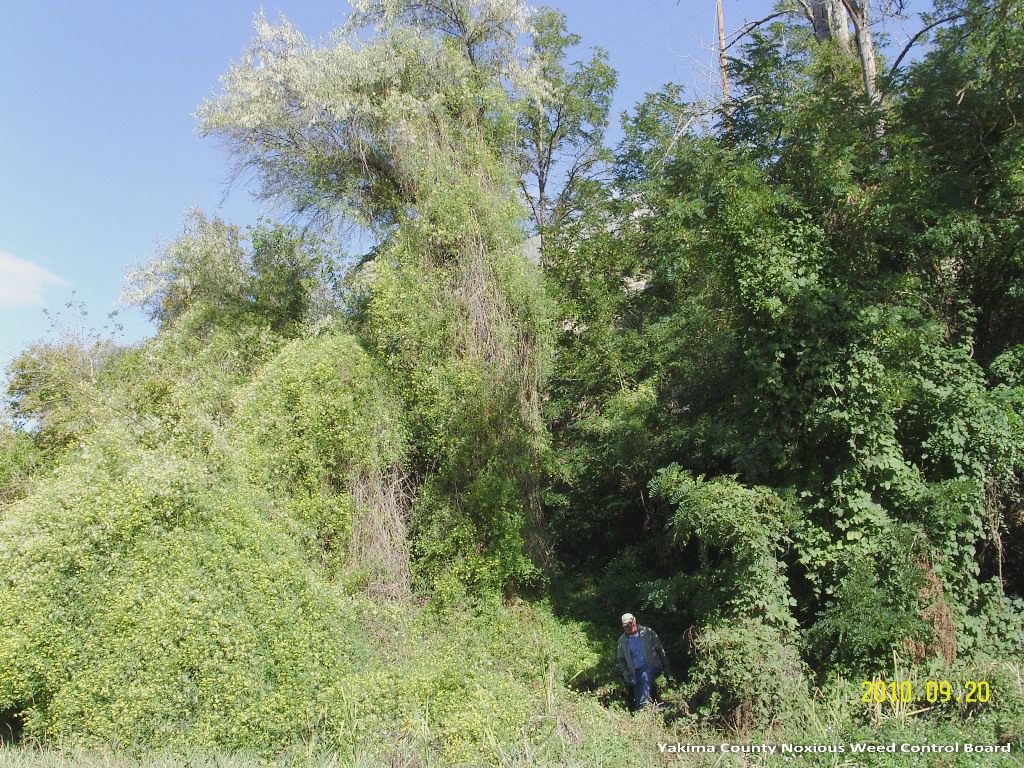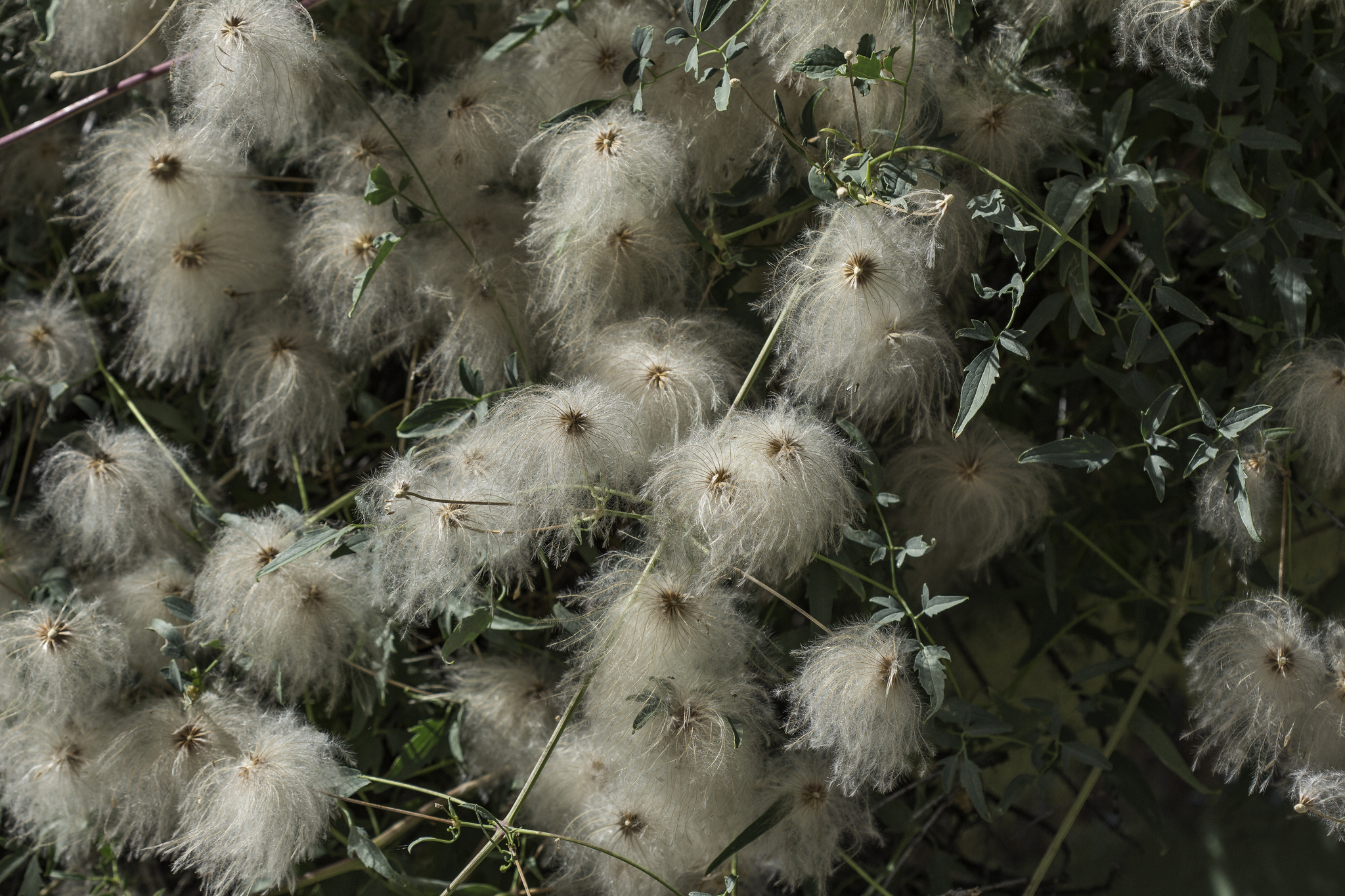Orange peel clamatis identification and control
Information about the noxious weed orange peel clematis. Orange peel clematis is also known by its Latin name, Clematis orientalis.
About this weed
Orange peel clematis is a regulated Class A noxious weed. This means eradication is required state-wide. Orange peel clematis is also on the Washington state quarantine list making it illegal to buy, sell, or offer it for sale in the state.
Orange peel clematis is known as Clematis orientalis and it is in the buttercup family. It is also known as oriental clematis. Its native range is in eastern Europe and Asia.

Why it's a problem
Orange peel clematis is a vine that can grow densely and completely cover trees, walls, and fences. It can crowd out other plants and damage young trees and bushes by weighing them down. Also, the juice of freshly crushed leaves and stems may cause blisters. Orange peel clematis is difficult to control once established. In Washington, orange peel clematis is limited to a few large infestations near the Yakima River, but it may also be present in gardens. It has the potential to establish in a variety of habitats so early detection and action is critical. Because it is not yet found in King County, we have an opportunity to keep it from spreading.
Plant description
Orange peel clematis is a deciduous vine (loses leaves annually) or scrambling shrub with yellow flowers. It tolerates open, sunny areas as well as part-shade. It grows in well-drained soils like riversides, rocky slopes, and roadsides. Identification can be tricky because similar species have been sold in nurseries, sometimes with the same names.
Stems are slender and ridged and can grow three feet per year up to 27 feet long. Leaves are divided into three to seven leaflets and are opposite (leaves which connect to the stem in pairs). Blooming occurs August - September. Flowers can be single or clustered on stems up to 4 inches long. Flowers have four yellow to greenish-yellow sepals (look like petals) that are about one inch long. The sepals spread outward and tend to curve back at the tips as flowers mature. Seedheads look like pom poms because the fluffy winged seeds (achenes) are clustered in a ball shape. The feathery seeds persist through winter and are carried by wind. This plant can also spread vegetatively from the sprawling stems.




Be aware of look-alike plants
Orange peel clematis may be confused with the eastern Washington native Clematis ligusticifolia or the invasive old man's beard, Clematis vitalba but both of those species have creamy white flowers, not yellow.
It may also be confused with other cultivated yellow clematis species, especially Clematis tangutica. C. tangutica leaves are finely toothed on the edges and it has brighter yellow flowers that are nodding and bell-shaped. Orange peel clematis flowers are more spreading and curved back at the tips.
What to do if you find it
Property owners are required to control orange peel clematis on lands that they manage. Please notify us if you see it growing in King County. Our program staff can provide the property owner or appropriate public agency with site-specific advice on how best to remove it. We map all known locations of regulated noxious weeds to help us and others locate new infestations in time to control them.
It is difficult to distinguish orange peel clematis from other clematis species. We recommend contacting the noxious weed program for identification help before removing. There are currently very few records of this plant our area, so if you do find it in King County, please report the location right away.
Control methods
In areas with few weeds, it is important to act quickly before they become harder to control. Make a long-term plan as it often takes several years to get rid of most weeds. Start in the least infested areas first and then move into more heavily infested areas. To reduce costs and environmental impacts, please consider a combination of methods.
Prevention
Orange peel clematis is sometimes sold as a garden plant, so be careful to check the Latin names of plants you are buying to avoid introducing this species. If plants have seedheads, be very careful not to spread them when removing plants.
Small patches
Vines can be pulled off trees and structures if it is safe to do so. The juice of freshly crushed leaves and stems may cause blisters, so wear gloves. The roots and lower vines need to be removed and that will kill the upper vines even if you cannot pull them down. Cut and remove the lower stems and pull them up by the roots.
Chemical control of larger patches
Manual removal can be effective but for large sites it may not be feasible, especially on steep, rocky slopes. Several systemic herbicides are reported to be effective. For specific chemical recommendations, please refer to the PNW Pest Management Handbook. Always read the label before using herbicide and follow state and local regulations.
Disposal instructions
Discard all plant material in the garbage to avoid spreading this plant further. Be careful of the juice of freshly crushed leaves and stems as it may cause blisters.
Washington State Noxious Weed Control Board pamphlet on noxious weed disposal

 Translate
Translate